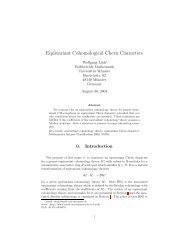Connes-Chern Character for Manifolds with Boundary and ETA ...
Connes-Chern Character for Manifolds with Boundary and ETA ...
Connes-Chern Character for Manifolds with Boundary and ETA ...
You also want an ePaper? Increase the reach of your titles
YUMPU automatically turns print PDFs into web optimized ePapers that Google loves.
where the map ι(h) is defined by<br />
CONNES-CHERN CHARACTER AND <strong>ETA</strong> COCHAINS 13<br />
ι(h)(a 0 ⊗ a 1 ⊗ . . . ⊗ a l )<br />
l∑<br />
= (−1) i (a 0 ⊗ . . . ⊗ a i ⊗ h ⊗ a i+1 ⊗ . . . ⊗ a l ).<br />
i=0<br />
(1.16)<br />
A relative K-theory class in K 0 (A, B) can be represented by a triple (p, q, h) <strong>with</strong><br />
projections p, q ∈ Mat N (A) <strong>and</strong> h : [0, 1] → Mat N (B) a smooth path of projections<br />
<strong>with</strong> h(0) = σ(p), h(1) = σ(q) (cf. [HiRo00, Def. 4.3.3], see also [LMP09, Sec. 1.6]).<br />
The <strong>Chern</strong> character of (p, q, h) is represented by the relative cyclic cycle<br />
( ) )<br />
ch • p, q, h =<br />
(ch • (q) − ch • (p) , − T/ch •<br />
(h) , (1.17)<br />
where<br />
T/ch •<br />
(h) =<br />
∫ 1<br />
0<br />
/ch •<br />
(<br />
h(s), (2h(s) − 1) ḣ(s) ) ds. (1.18)<br />
That the r.h.s. of Eq. (1.17) is a relative cyclic cycle follows from the transgression<br />
<strong>for</strong>mula Eq. (1.14). From a secondary transgression <strong>for</strong>mula [LMP09, (1.43)] one deduces<br />
that (1.17) indeed corresponds to the st<strong>and</strong>ard <strong>Chern</strong> character on K 0 (J ) under<br />
excision.<br />
1.3.2. Odd case. The odd case parallels the even case in many aspects. Given an<br />
element g ∈ GL ∞ (A) := lim GL N(A), the odd <strong>Chern</strong> character is the following normalized<br />
periodic cyclic cycle:<br />
N→∞<br />
∞∑<br />
(<br />
ch • (g) = (−1) k k! tr 2k+1 (g −1 ⊗ g) ⊗(k+1)) . (1.19)<br />
k=0<br />
If (g s ) 0≤s≤1 is a smooth path in GL ∞ (A), the transgression <strong>for</strong>mula (cf. [Get93b,<br />
Prop. 3.3]) reads<br />
d<br />
ds ch •(g s ) = (b + B) /ch •<br />
(g s , ġ s ), (1.20)<br />
where the secondary <strong>Chern</strong> character /ch •<br />
is defined by<br />
/ch •<br />
(g, h) = tr 0 (g −1 h)+ (1.21)<br />
∞∑<br />
k∑ (<br />
+ (−1) k+1 k! tr 2k+2 (g −1 ⊗ g) ⊗(j+1) ⊗ g −1 h ⊗ (g −1 ⊗ g) ⊗(k−j)) .<br />
k=0<br />
j=0<br />
A relative K-theory class in K 1 (A, B) can be represented by a triple (U, V, h), where<br />
U, V ∈ Mat N (A) are unitaries <strong>and</strong> h : [0, 1] → Mat N (B) is a path of unitaries joining<br />
σ(U) <strong>and</strong> σ(V ). Putting<br />
T/ch •<br />
(h) =<br />
∫ 1<br />
0<br />
/ch •<br />
(<br />
hs , ḣs)<br />
ds, (1.22)<br />
the <strong>Chern</strong> character of (U, V, h) is represented by the relative cyclic cycle<br />
( ) )<br />
ch • U, V, h =<br />
(ch • (V ) − ch • (U) , − T/ch •<br />
(h) . (1.23)

















